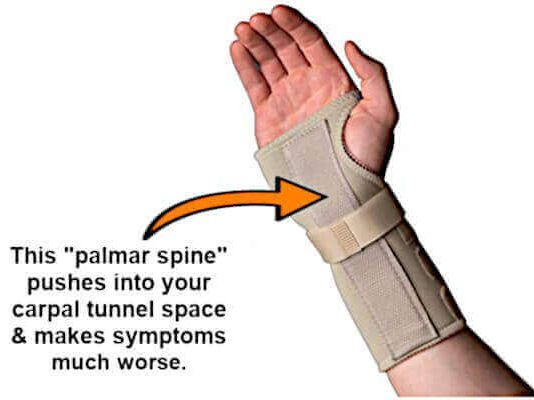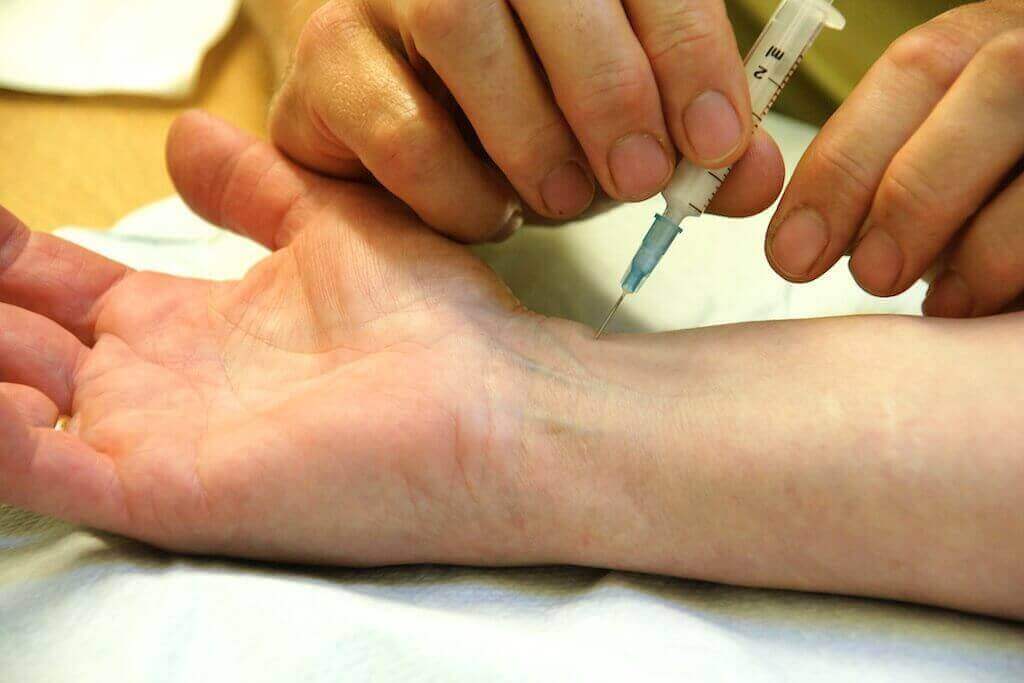What Causes an Electric Shock Feeling in Your Hand?
An electric shock-like jolt in your hand usually signals nerve irritation or compression caused by carpal tunnel syndrome. Discover how it happens and how to ease the symptom.
A sudden electric-shock sensation in your hand or fingers often arises when a nerve is pinched—commonly the median nerve in conditions such as carpal tunnel syndrome. These jolts can be triggered by gripping or bending the wrist. Recognizing the pattern helps you identify the cause early and take steps to relieve the symptom.
Table of Contents
- Overview
- Understanding Carpal Tunnel Syndrome
- Why Do Electric Shocks Happen?
- Other Symptoms of Carpal Tunnel Syndrome
- Managing Carpal Tunnel Syndrome: Treatments Tailored for Severity
- Mild Stage Cases
1) Rest and Activity Modification
2) Core Stretching Exercises
3) Night Bracing
4) Heat
1) Myofascial Release Massage
2) Non-Steroidal Anti-Inflammatory Drugs (NSAIDs)
3) Corticosteroid Injections
1) Carpal Tunnel Release Surgery
2) Myofascial Release Massage
- Prevention tips
- Take Regular Breaks
- Perform Stretching Exercises
- Avoid Harmful Activities
- Protect Your Hands
- Summary
- FAQs
- About
Overview
By Dr. M. Zannakis | The CarpalRx
Carpal tunnel syndrome is a condition that affects millions of people worldwide. Exactly why it occurs—and why you sometimes feel an electric shock in your hand—is explained here. Most importantly, you’ll learn how to manage carpal tunnel syndrome effectively based on the severity of your symptoms.
If you’ve ever felt a sudden, electric-like jolt in your hand or fingers, you know how startling it can be. It often happens when you grip or lift something—like holding a coffee mug, turning a doorknob, or picking up a frying pan. The sensation can shoot through the wrist and into the fingers, leaving a sharp, tingling, or burning feeling that quickly fades but may return again and again.
For some, this occurs only once in a while. For others, it becomes a daily disturbance that interferes with simple activities such as typing, cooking, or driving.
This “electric shock” feeling is not normal—it’s a clear sign that a nerve is being irritated or compressed. The most common cause is
carpal tunnel syndrome, in which pressure on the
median nerve inside the wrist produces those sudden, shooting sensations. Other nerve-related conditions, such as
peripheral neuropathy, can cause similar feelings, but carpal tunnel syndrome remains the most frequent culprit.
This article explains why these shocks happen, what they mean, and how to address them before they worsen.
Electric shocks due to carpal tunnel? Stop the pain - SHOP the CarpalRx!
Understanding Carpal Tunnel Syndrome
Carpal tunnel syndrome arises when there's damage to your
median nerve. This nerve runs from your forearm into your hand. Damage occurs when it becomes compressed as it passes through the carpal tunnel. The
carpal tunnel is a narrow passageway in your wrist which also contains tendons that allow you to grasp with your fingers.
This median nerve compression causes a type of damage called
neuropathy. And it can lead to
various symptoms, including
pain,
numbness, tingling,
weakness, and that characteristic sensation of an
electric shock.
The carpal tunnel passageway is surrounded by bones and ligaments. Any swelling or narrowing in this space can press on the median nerve. This nerve is responsible for sensation in most of your fingers (except the pinky). It also controls some of the muscles at the base of your thumb. When it’s compressed, it can’t function properly, leading to the discomfort associated with carpal tunnel syndrome.
Why Do Electric Shocks Happen?
The electric shock feeling in your hand is a direct result of irritation or compression of the median nerve. When this nerve is pinched, it sends erratic or abnormal signals to the brain. These signals are interpreted as sharp, jolting sensations akin to an electric shock. Your brain can also interpret the signals as pain, numbness or tingling.
Factors that can exacerbate median nerve compression include:
- Repetitive hand movements: Typing, sewing, or assembly line work.
- Prolonged wrist positioning: Sleeping with your wrist bent or holding tools awkwardly.
- Various harmful hand activities: Like prolonged grip-and-release motions or extensive gripping and squeezing.
- Underlying medical conditions:
Diabetes,
thyroid disorders, or
rheumatoid arthritis, which can increase swelling or inflammation in the wrist.
Other Symptoms of Carpal Tunnel Syndrome
In addition to an electric shock feeling in your hand, people with carpal tunnel syndrome may experience:
- Pain: Localized in the hand, fingers or wrist; sometimes radiating up the arm.
- Tingling or numbness: Often affecting the thumb, index, and middle fingers, especially at night.
- Weakness and dexterity problems: Difficulty gripping objects or performing fine motor tasks like tying a shoelace.
- Burning: Sensations can range from itching to burning anywhere between the fingers and wrist.
- Clumsiness: Dropping objects due to loss of sensation or weakness.
These symptoms often start gradually, mostly at night. If left untreated, they generally worsen over time, and extend into the daytime.
Managing Carpal Tunnel: Treatments by Severity
The good news is that carpal tunnel syndrome can often be managed effectively, especially when caught early. Treatment approaches depend on the severity or "stage" of the condition.
- Mild stage carpal tunnel:
Usually the most treatable, where symptoms are uncomfortable while trying to sleep.
- Moderate stage carpal tunnel:
When symptoms spill over into the daytime and usually interfere with your daily activities.
- Severe stage carpal tunnel:
When symptom are maximally intense, and impact your quality of life.
- End stage carpal tunnel:
When your median nerve is severely damaged and treatment outcomes are grim.
Mild Stage Cases
For mild stage carpal tunnel syndrome, the goal is to reduce pressure on the median nerve and prevent its progression.
1) Rest and Activity Modification
- Take regular breaks from repetitive or other
harmful activities.
- Avoid positions that exacerbate symptoms, such as prolonged wrist flexion (like doing push-ups).
2) Core Stretching Exercises
There are
4 core stretching exercises which can improve tendon health, increase circulation, and reduce tension in the wrist. These stretches are below. They should be performed regularly, especially when stressing your hands. A more comprehensive discussion can be found at
Stretching Exercises for Carpal Tunnel.
- Stop stretch: Extend your hand, with fingers up, like saying, "Stop!" Pull back the upturned fingers with your other hand.
- Prayer stretch: Put your hands together, chest level, as in a prayer. Then slowly raise your elbows
only.
- Finger interlace stretch: Interlace your fingers and extend your palms outward in front of you.
- Thumb stretch: Grasp you thumb and twirl it around like a helicopter blade.
3) Night Bracing
Wearing a wrist brace while sleeping helps keep your wrist in a neutral position. This reduces pressure on the median nerve. Night bracing (or "nocturnal splinting") is particularly effective for people whose symptoms worsen during sleep.
Caution:
Wear only a "certified" carpal tunnel brace, and never a brace containing a palmar spine. (Such harmful braces are often sold in pharmacies, and can cause more nerve damage.)
See this explanation about proper night bracing.
4) Heat
If you have symptoms of carpal tunnel syndrome, keeping you hand warm is important. And applying heat is extra beneficial because it speeds healing.
Heat therapy has
numerous beneficial effects. It promotes blood flow, which is necessary to carry restorative oxygen and nutrients to damaged tissues. It also carries away damaged cellular debris.
Apply heat to your hand at night, before sleeping, for about 15 minutes. It's best to use a
Heating Mitt or a heating pad rolled into a tube. (Hold the rolled-up shape with tape.) That's because heating both sides of the hand is optimal for healing.
Moderate Stage Cases
If symptoms persist or worsen despite conservative measures, more intensive interventions may be needed.
1) Myofascial Release Massage
- A skilled therapist uses
myofascial release massage to reduce tension and adhesions in the tissues surrounding the carpal tunnel. This process takes time, but is very effective -- with a
97% patient satisfaction rate. It removes adhesions which cause inflammation around tendons. The inflammation produces swelling, which crushes the median nerve.
- The
CarpalRx is an automated device providing the identical myofascial release massage at home, without the need of a human therapist.
Learn more about the CarpalRx.
How Severe is Your Carpal Tunnel? Take Dr. Z's Quiz
2) Non-Steroidal Anti-Inflammatory Drugs (NSAIDs)
Over-the-counter
NSAID medicines such as ibuprofen and naproxen can help reduce inflammation. Less inflammation means less pressure on the median nerve, which alleviates the discomfort. Of course, once the medicine wears off in a few hours, the inflammation returns. This is why such medicines are considered a short-term remedy. Furthermore, long-term use of NSAIDs can result in
kidney damage.
3) Corticosteroid Injections
In some cases, a doctor may recommend
corticosteroid injections into your wrist area. The steroid reduces swelling around the median nerve. The success rate of a corticosteroid injection at the moderate stage of carpal tunnel syndrome is
about 45%. There can be significant
side effects to the injection. Recurrence of symptoms occurs in about
60% of patients after 3-4 months.
Severe Stage Cases
1) Carpal Tunnel Release Surgery
This procedure involves cutting the ligament that forms the roof of the carpal tunnel. The goal is to create more space for the median nerve which is being compressed by swollen tendons. Surgery is typically performed on an outpatient basis. Two types of surgery can be used, and both have
advantages and disadvantages:
- Open carpal tunnel release surgery: More painful and takes longer to recover.
- Endoscopic carpal tunnel release surgery: Less painful and quicker recovery time.
The patient satisfaction rate with either procedure is
about 50-60%. Symptoms may return within 2 years. After surgery,
post surgical rehabilitation is necessary. This is crucial to restoring hand strength and wrist flexibility.
2) Myofascial Release Massage
- This treatment is identical to that applied for moderate carpal tunnel syndrome. A therapist can use myofascial release massage even in severe cases to reduce tension and adhesions inside the carpal tunnel. In the severe stage, it's even more crucial to remove inflammation-causing adhesions around tendons which crush the median nerve. The healing process takes more time than with moderate cases, and is
80-90% effective.
Electric shocks due to carpal tunnel? Stop the pain - SHOP the CarpalRx!
Prevention Tips
Preventing carpal tunnel syndrome or minimizing its progression involves adopting wrist-friendly habits:
1) Take Regular Breaks
Taking regular "rest" breaks from stressful hand activities can help reduce the strains you put on your hand and fingers. The "30-30" rule is best to follow. That means for every 30 minutes of stressful hand activity (like typing) take a 30 second break. Your break will be even more effective when, during that break, you perform the
4 core stretching exercises below.
2) Perform Stretching Exercises
The
4 core stretching exercises discussed above are crucial to preventing carpal tunnel syndrome. A more in-depth discussion of each exercise can be found at
Stretching Exercises for Carpal Tunnel.
3) Avoid Harmful Activities
Most people can prevent carpal tunnel syndrome if they disengage from harmful hand activities. Pay attention to your hand/finger activities and adopt more finger or wrist-friendly habits. The
specific
finger and hand motions which can result in carpal tunnel can be found at
Harmful Activities.
4) Protect Your Hands
Protecting you hands can mean different things to different people. For instance, wear insulated gloves to never allow your hands to get cold. Wear thick padded gloves when riding a bike, lifting weights, or using
vibrating tools. Use ergonomic equipment (mouse, keyboard, scissors, can opener, etc.) when possible. And of course, use
proper sitting posture when typing.
Summary
Getting an electric shock feeling in your hand can be alarming. But it’s often a telltale sign of carpal tunnel syndrome. Understanding why this sensation occurs — and addressing the underlying cause — is key to finding relief. Whether your symptoms are mild, moderate, or severe, a range of treatment options are available to help you regain comfort and functionality. By taking proactive steps, you can manage carpal tunnel syndrome effectively and keep your hands healthy for years to come.
FAQs
- Did my job cause carpal tunnel?
It's hard to pinpoint any specific cause of this disorder. Carpal tunnel syndrome can arise for many reasons. Certainly, specific hand activities are known to be risk factors for getting carpal tunnel.
- Does everybody with carpal tunnel get shooting electric shocks?
No. There is no set of symptoms common to everybody. However, pain, numbness, tingling, weakness, and shooting electric shocks (or any combination of these) are the most common symptoms.
- What's the best treatment for carpal tunnel?
Treatment depends on your severity. Treatments for less severe cases include resting, stretching exercises, night bracing, and myofascial massage. More advanced carpal tunnel cases may require hydrodissection or surgery.
- What's the best way to prevent carpal tunnel?
Take preventive measures like resting your hand, performing regular stretching exercises, avoiding harmful activities, and protecting you hand from injury (like vibration).
About












